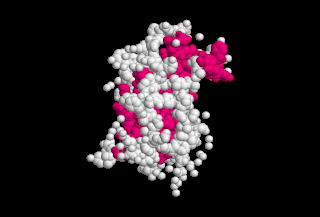
Growth hormone (GH) or somatotropin, also known as human growth hormone in its human form, is a peptide hormone that stimulates growth, cell reproduction, and cell regeneration in humans and other animals. It is thus important in human development. GH also stimulates production of IGF-1 and increases the concentration of glucose and free fatty acids. It is a type of mitogen which is specific only to the receptors on certain types of cells. GH is a 191-amino acid, single-chain polypeptide that is synthesized, stored and secreted by somatotropic cells within the lateral wings of the anterior pituitary gland.

Gigantism, also known as giantism, is a condition characterized by excessive growth and height significantly above average. In humans, this condition is caused by over-production of growth hormone in childhood, resulting in people up to 2.7 m (9.0 ft) in height.

Insulin-like growth factor 1 (IGF-1), also called somatomedin C, is a hormone similar in molecular structure to insulin which plays an important role in childhood growth, and has anabolic effects in adults.
Ronald Mark Evans is an American Biologist, Professor and Head of the Salk’s Gene Expression Laboratory, and the March of Dimes Chair in Molecular and Developmental Biology at the Salk Institute for Biological Studies in La Jolla, California and a Howard Hughes Medical Institute Investigator. Dr. Ronald M. Evans is known for his original discoveries of nuclear hormone receptors (NR), a special class of transcriptional factor, and the elucidation of their universal mechanism of action, a process that governs how lipophilic hormones and drugs regulate virtually every developmental and metabolic pathway in animals and humans. Nowadays, NRs are among the most widely investigated group of pharmaceutical targets in the world, already yielding benefits in drug discovery for cancer, muscular dystrophies, osteoporosis, type II diabetes, obesity, and cardiovascular diseases. His current research focuses on the function of nuclear hormone signaling and their function in metabolism and cancer.

Zvi Laron is an Israeli paediatric endocrinologist. Born in Cernăuţi, Romania, Laron is a professor emeritus at Tel Aviv University. In 1966, he described the type of dwarfism later called Laron syndrome. His research opened the way to the treatment of many cases of growth hormone disorders. He was the first to introduce the multidisciplinary treatment for juvenile diabetes.

Growth hormone receptor is a protein that in humans is encoded by the GHR gene. GHR orthologs have been identified in most mammals.

Laron syndrome (LS), also known as growth hormone insensitivity or growth hormone receptor deficiency (GHRD), is an autosomal recessive disorder characterized by a lack of insulin-like growth factor 1 production in response to growth hormone. It is usually caused by inherited growth hormone receptor (GHR) mutations.
Growth hormone-binding protein (GHBP) is a soluble carrier protein for growth hormone (GH). The full range of functions of GHBP remains to be determined however, current research suggests that the protein is associated with regulation of the GH availability and half-life in the circulatory system, as well as modulating GH receptor function.

Growth hormone secretagogue receptor(GHS-R), also known as ghrelin receptor, is a G protein-coupled receptor that binds growth hormone secretagogues (GHSs), such as ghrelin, the "hunger hormone". The role of GHS-R is thought to be in regulating energy homeostasis and body weight. In the brain, they are most highly expressed in the hypothalamus, specifically the ventromedial nucleus and arcuate nucleus. GSH-Rs are also expressed in other areas of the brain, including the ventral tegmental area, hippocampus, and substantia nigra. Outside the central nervous system, too, GSH-Rs are also found in the liver, in skeletal muscle, and even in the heart.

The growth-hormone-releasing hormone receptor (GHRHR) is a G-protein-coupled receptor that binds growth hormone-releasing hormone. The GHRHR activates a Gs protein that causes a cascade of cAMP via adenylate cyclase.
Bert W. O’Malley is the Tom Thompson Distinguished Service Professor of Molecular and Cellular Biology and Chancellor at Baylor College of Medicine. A native of Pittsburgh, he has a bachelor's degree from the University of Pittsburgh and a M.D. from their School of Medicine (1963). He completed his residency at Duke University and spent four years at the National Institute of Health followed by four years serving as the Luscious Birch Professor and the director of the Reproductive Biology Center at Vanderbilt University. He then moved to Baylor as Professor and Chairman of Molecular and Cellular Biology.
Pegvisomant, sold under the brand name Somavert, is a growth hormone receptor antagonist used in the treatment of acromegaly. It is primarily used if the pituitary gland tumor causing the acromegaly cannot be controlled with surgery or radiation, and the use of somatostatin analogues is unsuccessful, but is also effective as a monotherapy. It is delivered as a powder that is mixed with water and injected under the skin.

Ibutamoren (INN) is a potent, long-acting, orally-active, selective, and non-peptide agonist of the ghrelin receptor and a growth hormone secretagogue, mimicking the growth hormone (GH)-stimulating action of the endogenous hormone ghrelin. It has been shown to increase the secretion of several hormones including GH and insulin-like growth factor 1 (IGF-1) and produces sustained increases in the plasma levels of these hormones without affecting cortisol levels.
Breast development, also known as mammogenesis, is a complex biological process in primates that takes place throughout a female's life.

The Heritage College of Osteopathic Medicine (OU-HCOM) is the medical school of Ohio University and the only osteopathic medical school in the U.S. state of Ohio. Its mission is to emphasize the practice of primary care and train physicians to serve Ohio, especially in the underserved Appalachian and urban areas of the state.

Pierre De Meyts is a Belgian physician and biochemist known for his research on fine chemical and kinetic aspects of ligand-receptor interaction, subunit assembly, and specific metabolic effects of hormones typically causing receptor tyrosine kinase activation such as insulin and insulin-like growth factors (IGFs). He has also studied receptor signalling for other peptide hormones such as growth hormone and relaxin, and key pathophysiological aspects of diabetes mellitus. De Meyts held professorial posts for over three decades at several European and United States institutions and currently is an emeritus professor in the Science Faculty at the Université catholique de Louvain. While living in Denmark (1990-2010) he occupied executive research positions at Novo Nordisk. De Meyts is also known as a science cartoonist.

Daniel Joshua Drucker is a Canadian endocrinologist. A Fellow of the Royal Society, he is a professor of medicine at the Lunenfeld-Tanenbaum Research Institute, Mount Sinai Hospital, Toronto. He is known for his research into intestinal hormones and their use in the treatment of diabetes and other metabolic diseases.

Examorelin (INN) (developmental code names EP-23905, MF-6003), also known as hexarelin, is a potent, synthetic, peptidic, orally-active, centrally-penetrant, and highly selective agonist of the ghrelin/growth hormone secretagogue receptor (GHSR) and a growth hormone secretagogue which was developed by Mediolanum Farmaceutici. It is a hexapeptide with the amino acid sequence His-D-2-methyl-Trp-Ala-Trp-D-Phe-Lys-NH2 which was derived from GHRP-6. These GH-releasing peptides have no sequence similarity to ghrelin, but mimic ghrelin by acting as agonists at the ghrelin receptor.
Benita S. Katzenellenbogen née Schulman is an American physiologist and cell biologist at the University of Illinois at Urbana-Champaign. She has studied cancer, endocrinology, and women's health, focusing on nuclear receptors. She also dedicated efforts to focusing on improving the effectiveness of endocrine therapies in breast cancer.

Keith Kelley is an American immunophysiologist, researcher and academic. He is Professor Emeritus of Immunophysiology at the University of Illinois and Editor-In-Chief Emeritus of Brain, Behavior, and Immunity. He is a Past-President and Secretary-Treasurer of the Psychoneuroimmunology Research Society.














